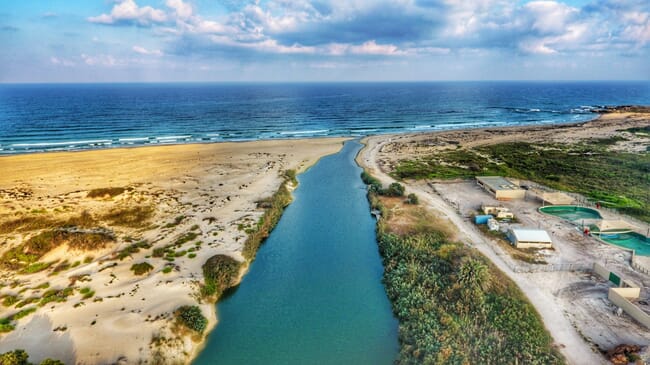So suggest the authors of a new study by Tel Aviv University and Berkeley University in which they built a model for growing Mediterranean stalk kelp near the Alexander River estuary, in Israel, hundreds of metres from the open sea. The river was chosen because it discharges polluting nitrogen from nearby upstream fields and settlements into the Mediterranean. Data for the model were collected over two years from controlled cultivation studies.

The researchers explain that nitrogen is a necessary fertiliser for agriculture, but once it reaches the ocean, it disperses randomly, damaging various ecosystems. As a result, the state currently spends a great deal of money on treating nitrogen concentrations in water, and there are international agreements that limit nitrogen loading in the oceans, including in the Mediterranean.
“My laboratory researches basic processes and develops technologies for aquaculture,” explained Professor Alexander Golberg from Tel Aviv University, in a press release. “We are developing technologies for growing seaweed in the ocean in order to set carbon and extract various substances from them, such as proteins and starches, in order to produce the agricultural produce in the ocean as well. In this study, we showed that if seaweed is grown according to the model we developed, in close proximity to streams and rivers’ estuaries, they can absorb the nitrogen to conform to environmental standards and prevent its dispersal in water and thus neutralise environmental pollution. In this way, we actually produce a kind of ‘natural decontamination facility’ with significant ecological and economic value since seaweed can be sold as biomass for human use.”
The researchers add that the mathematical model predicts farm yields and links seaweed yield and chemical composition to nitrogen concentration in the river.
“Our model allows marine farmers, as well as government and environmental bodies, to know, in advance, what the impact will be and what the products of a large seaweed farm will be – before setting up the actual farm,” added Miron Zollman. “Thanks to mathematics, we know how to make the adjustments also concerning large agricultural farms and maximise environmental benefits, including producing the agriculturally desired protein quantities.”
“It is important to understand that the whole world is moving towards green energy, and kelp can be a significant source,” added Prof Alexander Liberzon. “Yet today there is no single farm with the proven technological and scientific capability. The barriers here are also scientific: we do not really know what the impact of a huge farm will be on the marine environment. It is like transitioning from a vegetable garden outside the house to endless fields of industrial farming. Our model provides some of the answers, hoping to convince decision-makers that such farms will be profitable and environmentally friendly. Furthermore, one can imagine even more far-reaching scenarios. For example, green energy: if we knew how to utilise the growth rates for energy in better percentages, it would be possible to embark on a one-year cruise with a kilogram of seaweed, with no additional fuel beyond the production of biomass in a marine environment.”
“The interesting connection we offer here is growing seaweed at the expense of nitrogen treatment,” concludes Prof Goldberg. “In fact, we have developed a planning tool for setting up seaweed farms in river estuaries to address both environmental problems and derive economic benefit. We offer the design of seaweed farms in streams and rivers containing large quantities of agriculturally related nitrogen residues to rehabilitate the stream and prevent nitrogen from reaching the ocean while growing the seaweed itself for food. In this way, aquaculture complements terrestrial agriculture.”
Further information
The study is published in Communications Biology under the title Multi-scale modeling of intensive macroalgae cultivation and marine nitrogen sequestration.


